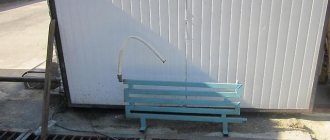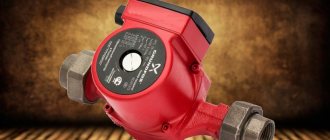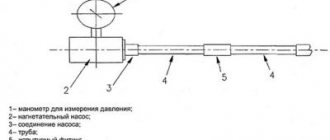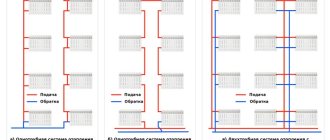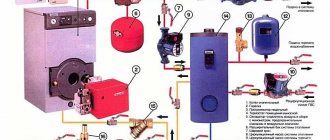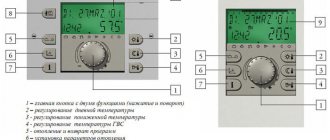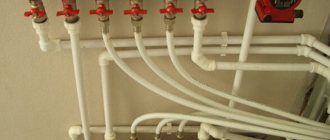What to do if bimetallic batteries do not heat up?
If during the heating season the apartment is not warm enough, then viral and cold diseases appear. Let's consider in what case bimetallic batteries do not heat up and what are the reasons?
First, make sure that the room temperature is below the established standards, which are as follows:
- If the room is located on the ground floor, then it should warm up to +20°C, and in the living room up to +18°C;
- The kitchen should warm up to +18°C;
- Bath up to +25°C;
- Corner room up to +20°C;
- At the entrance, on the staircase it should be up to +16°C;
- In the attic and basement up to +4°C;
- In the elevator up to +5°C.
How to correctly measure the room temperature?
In each room, measurements are taken at a distance of 100 cm from the inner wall, and it should be 150 cm from the floor. If they do not meet the above requirements, then there may be the following reasons:
- Debris has accumulated in the radiator;
- Air has collected in the system.
Radiators are dirty
First, check the pipes. If they are hot, then talk to your neighbors, if they heat up normally, then the reason is your radiators, which are clogged with dirt (metal oxide or other debris that does not allow the coolant to circulate freely). If you touch the top of the battery and feel that it is hot and cold at the bottom, then debris and dirt are located at the bottom. In this case, warm up the radiator from below, the coolant will heat up and begin to move through the system, and possibly dirt will leave with it.
It is quite difficult to clean dirty heating devices on your own, and therefore it is better to contact specialists who will clean them quickly and efficiently.
There is air in the radiator
It is important! Even if the heating radiators are new, and therefore not clogged with debris and dirt, then they have accumulated air, which can be removed independently. Each device has a tap, and by opening it you can drain the water, which will release air and cause the batteries to heat up.
The taps can also be installed on the riser. If a regular tap is installed, then you can simply open it, but if a Mayevsky tap is installed, then it is automatic and to open it you need to unscrew the cap and press the valve to drain the water, but before that you need to place a vessel under the heating device.
Next, close the tap and the radiator begins to heat up.
If you live in a private house and the bimetallic batteries do not heat well, then check each of the installed radiators and, if necessary, open the Mayevsky tap and drain the water.
Installation
Let's consider the existing types of connecting a heating battery to the system, which can be:
- Lateral;
- Nizhny;
- Diagonal.
With a lateral (one-sided) connection, the taps enter the radiator from the side, which ensures that the battery operates at maximum power, and if necessary, the heater can be easily replaced. If the length of the heating unit exceeds 160 cm, then a diagonal connection is used.
When the battery is connected to the bottom side, 90% of the total power of the heater is used. But such a connection is used extremely rarely, only in the case of baseboard wiring.
The bottom connection is used only when connecting to the heating system those heating devices that are designed specifically for this type of connection.
The diagonal connection to the system also ensures high-quality operation of the radiators, with the inlet pipe connected on one side from the top, and the outlet pipe on the opposite side from the bottom. This type is considered the best.
What do installation errors lead to?
If the radiators are not connected correctly, then the water is supplied not from above, but from below, and therefore it passes below and does not warm up the entire heating device. In this case, a coolant flow extension can help.
If the first few sections of the radiator are warming up and the owner is tormented by the question: - why doesn’t the bimetallic battery heat up? - the answer can be given by plumbers who will make calculations and correct all the shortcomings made during the installation of the system.
In order for the heating device to work properly and warm up the entire room efficiently, it is necessary to pay attention to the number of sections in a single unit, which should not be more than 12 (if the system is gravitational), and if it is circulation, then the number of sections should be from 20 to 24 knots. If there are more compartments, then the heater will not heat well.
If the diameter of the pipes for supplying the coolant is incorrectly selected, uneven heating of the batteries is also possible. For example, if the cross section is small, then the pressure is insignificant and is not enough to heat the system. To correct such an installation error, it is necessary to replace the pipes with the required diameter.
In order to increase the heat transfer of the heating device, it is necessary to keep it clean, and attach reflective material (foil can be used) to the wall behind it and paint the battery in a dark color (it emits thermal energy better).
Today it has become fashionable to install a heating battery with a thermostat in an apartment of a multi-storey or country house, but you don’t have to install a bypass pipe, but to do this, talk to representatives of the housing department.
Conclusion
For high-quality operation of the heating system, it is necessary to make the right choice when purchasing a heating device. How to connect a bimetallic battery to the utility network, or rather which connection method to use, is up to the owner of the apartment and the type of unit chosen.
In order for radiators to work well and heat the entire area, it is necessary to carry out high-quality installation in compliance with all requirements and recommendations. If this work cannot be carried out independently, you should contact specialists for help, who will quickly and with a quality mark install the heating system.
Source: https://santehkrug.ru/chto-delat-esli-ne-greyut-bimetallicheskie-batarei.html
Frequent reasons for a decrease in heat transfer from a heating battery
Most often, the reason for the decrease in heat transfer from radiators is scale and rust that accumulates inside. If the radiator itself is flushed (which utilities should do annually), the heat transfer will increase significantly. The same applies to heating risers. However, it will not be possible to carry out such a procedure on your own due to the fact that when carrying out such work (even in summer), it is necessary to drain the water from the system. You can’t do this without the help of specialists. The same applies to replacing radiators from cast iron to bimetallic ones - they have greater heat transfer. Therefore, we will not dwell on such complex and time-consuming options. It’s better to consider simpler methods that any home craftsman can do, even without experience in this field.
The heat output of bimetallic radiators is higher than that of cast iron
We use a reflective screen: the use of foamed polyethylene
Using a reflective screen is a fairly popular method of increasing heat transfer. Foamed polyethylene with a foil coating on one side is perfect for these purposes. Such a screen (it should be larger than the radiator itself) is placed behind the radiator with foil in the direction of the room and fixed to the wall with double-sided tape or liquid nails. Foamed polyethylene provides additional insulation, and the foil reflects the heat that warmed the wall before installing the screen, directing it into the room.
Important information! It is best when such moments are thought through at the stage of installing heating radiators. In this case, a steel ribbed shield can be attached to the radiator, which will accumulate heat and then direct it into the room. Such panels are convenient if heating outages occur frequently.
This is what a screen made of foil-foamed polyethylene looks like.
Also, basalt slabs with aluminum coating have proven themselves well as a screen.
Increasing heat transfer with additional accessories and painting
To increase the air temperature in the room, special aluminum casings are used, which are placed on the radiator. With their help, the area of the heating battery increases and, as a result, their heat transfer. The cost of such casings is low, but the effect is quite significant.
The color of the radiators is also of great importance. It is better to choose darker shades for these purposes. For example, a radiator painted brown has 20-25% more heat transfer than white ones.
This casing improves appearance and increases heat transfer
Improving convection by increasing air circulation
Everyone knows that improving air circulation helps the room warm up faster. For these purposes, you can use a fan, which is installed in such a way as to achieve maximum flow of warm air towards the room.
Helpful information! If you have computer coolers at home that are not in use, you can install them under the radiator, directing the air flow upward. This will maximize convection, causing the room to become significantly warmer.
You can increase convection (if the radiator is recessed under the window sill) by cutting holes in the window sill and covering them with screens or decorative covers . Thus, warm air will not linger in the niche, which will improve circulation.
It's impossible to win this country! Self-installation of fans to improve convection:
Why and why heating radiators do not heat up and how to fix it
In fact, there may be several reasons why heating radiators do not heat, so it is necessary to understand the situation in each individual case. Qualified assistance may be required to resolve the problem. You can achieve uniform heating of radiators yourself.
What are the reasons for radiators not fully warming up?
There are several common reasons for uneven heating of radiators. To troubleshoot the problem, you need to understand what exactly led to the existing violations.
- The last radiator in the heating system does not heat up - the reason is insufficient power of the circulation pump, non-observance of angles and slopes when installing the pipeline.
- The lower part of the heating radiator does not warm up completely - this problem is usually typical for aluminum heating radiators. In some cases, the cause is an incorrectly set mode of the thermostat installed on the coolant supply to the battery.
- Half of the radiator does not give off heat - a cold top indicates the presence of an air lock. If the outer sections are cold, this indicates an identical problem.
- The lower corner of the heating radiator is cold - errors made during installation. Bimetallic and aluminum batteries must be installed perfectly level. Distortions lead to uneven heating of sections.
Why do batteries warm up unevenly?
Bimetallic radiators or devices made of other materials are considered one of the main components of any heating system. Such devices effectively warm the air in the room and maintain a temperature favorable for humans when properly connected to the pipeline. There are times when the upper part of the radiator warms up well, but the lower part remains cold.
Important! The main reasons for the difference in temperatures at different levels of the radiator are considered to be its incorrect connection, when the technician mixed up the supply and return pipelines, as well as the low speed of the coolant. In the latter case, the liquid has time to completely release heat before leaving the heating device.
Why bimetallic radiators are hot at the top and cold at the bottom: reasons and solutions
In the era of global energy efficiency and energy conservation, having barely warm radiators at home is simply an unaffordable luxury. Uncomfortable microclimate, extra financial expenses - do we need it? I think no. Therefore, there is a reason to promptly identify and correct problems with the heating system, especially since you can perform some procedures yourself.
What are the consequences of inefficient operation of heating devices?
A certain part of homeowners believe that if bimetallic radiators are hot at the top and cold at the bottom, then there is no need to worry too much - it will somehow get better. In reality, this problem causes a lot of inconvenience, which may ultimately result in serious repairs:
- The efficiency of heating appliances decreases.
- Reducing the room temperature.
- Adjusting additional reinforcement does not correct the situation.
Important! Do not forget that a small temperature difference between the top and bottom of the batteries is not a significant indicator of malfunction. Another thing is a significant difference in heating; it negatively affects the heating efficiency.
New bimetallic radiators have a cold bottom while the top is hot: possible reasons
As already noted, for all models the heating of the lower region is weaker than that of the upper. This is explained by the high heat transfer of the bimetal - the water has time to cool thoroughly during the passage. Hence the temperature difference, which worries owners so much.
When not to worry
But with such insignificant differences there should be no reason for concern - this is a normal situation, given the features of this type of device:
- A single vertical channel in each section (for example, cast iron products have two).
- Small channel diameter (little coolant), but effective heat transfer due to the special configuration of the fins.
- Profiled convection channels between the ribs of the sections contribute to enhanced heat transfer, regardless of whether the battery is made by Italian or Russian.
- The thin walls of the sections heat up quickly, but also cool down just as quickly. Therefore, if you have bimetallic radiators at home and the bottom is cold and the top is hot near the appliances, this property needs to be taken into account.
Probable causes of uneven heat transfer
Despite similar trends, each case must be considered individually. If we ignore three important factors: incorrect calculation of the power of the boiler, pump and number of batteries, then we should take into account the likelihood of the following problems:
- Air jams are an inevitable consequence of measures to fill the structure with coolant. An additional symptom is gurgling or hissing sounds. The solution is the installation of a Mayevsky crane.
- Clogging of heating appliances is the result of neglecting regular flushing of the system, especially in apartments with a central heating system.
- Unsatisfactory coolant circulation - if distant heating units do not heat up well, then it is worth considering this reason, in particular in systems with natural circulation. To solve the problem when bimetallic radiators are hot at the top and too cold at the bottom, installing a circulation pump will help.
- Incorrect operation of the heating structure is a fairly common factor when the bypass is not adjusted. Even experienced home craftsmen who know how to properly install a battery with their own hands make mistakes when performing commissioning work.
- Problems with shut-off valves - proper installation of these units does not guarantee that over time the mechanism or electronic components will not fail.
Why are bimetallic radiators hot at the top and cold at the bottom after connecting: a reason to check the connections
Many home craftsmen decide to install it themselves, guided by considerations such as: there is nothing complicated here, or why spend extra money if you have the hands. This point of view is partially justified, but it would be nice to back it up with at least superficial theoretical information, which not many people do. So let's go over the top.
Incorrect installation of coolants: consequences
The main blunder when installing a two-pipe system is the incorrect choice of the direction of coolant flow in the pipes and its connection. A common mistake is that the pipe through which the supply flows is connected to the lower fitting of the heat exchanger, and the return is connected to the upper one. The result is obvious:
- Circulation processes are disrupted, and as a result, the efficiency of the system decreases.
- The removal of coolant from the device is disrupted; one half of the battery will heat up, but the other will not.
- Efficiency decreases, complete heat transfer is impossible due to incomplete filling with water.
The flow of hot liquid enters through the lower pipe, flows in a circle, and leaves the heating device without heating the sections. As a result, the bottom of even new bimetallic radiators is cold and the top is hot, and the efficiency of the system decreases. The fact is that the upper connection does not in any way contribute to the removal of coolant from the inside of the device, because its design does not allow the formation of increased pressure to remove water through the upper fitting.
Since a heated liquid has a lower density, unlike a cold one, when it gets inside, it tends to rise up. Therefore, the water follows the least path of resistance and does not mix in the sections.
How to fix the situation
A competent connection method guarantees the flow of hot water from above and facilitates its passage through the upper collector. Full heating is ensured by diagonal connection of radiators. However, it is not always done as expected, but it needs to be corrected. The algorithm is as follows:
- Disconnect the supply pipes from the fittings.
- Adjust the system diagram, taking into account that the supply flow goes through the upper pipe (it is connected to the upper pipe), and the return flow through the lower pipe.
- Connect the components to the heat exchanger.
- Open the supply and check the functioning of the system.
The radiator does not heat. What to do?
With the onset of cold weather, many are faced with the problem of non-functioning radiators and ask a reasonable question: “Why are the batteries cold? After all, everything was fine last winter.” This problem, by the way, is one of the most common in the heating sector. Why does this happen, what reasons can provoke the problem and what should you do if you freeze at the very beginning of winter? Let's figure it out.
Are the radiators in your apartment heating poorly?
So, first you need to do a superficial check. It doesn’t take much time, but in this way you can eliminate factors not related to breakdown or malfunction.
1. Pay attention to the valve. The battery may be blocked. In order to assess whether the valve is in the correct position, you need to remember that when open it must stand parallel to the pipe. When the valve is closed, it takes a perpendicular position. For clarity, take a look at the picture.
2. Contact the management company. There they must inform you about heating outages.
3. Discuss the problem with your neighbors. In many houses in our country, the coolant supply system is a single-pipe version. In simple terms, with such a system, one pipe goes to the ceiling and one to the floor. In addition, neighbors, as a rule, do not have jumpers between pipes (bypasses). Thus, when a neighbor on the second floor blocks the radiator, all the residents above will suffer, since heating, in this case, is turned off for all apartments along the riser. What should be done? It's simple: check if the heating of your neighbors below and above is blocked (in some cases, the coolant is supplied from the upper floors).
We have looked at the simplest reasons that can make you freeze in your own apartment. Unfortunately, heating problems are not always of such a banal nature, so we suggest that you familiarize yourself with the malfunctions and problems that are directly related to heating radiators.

